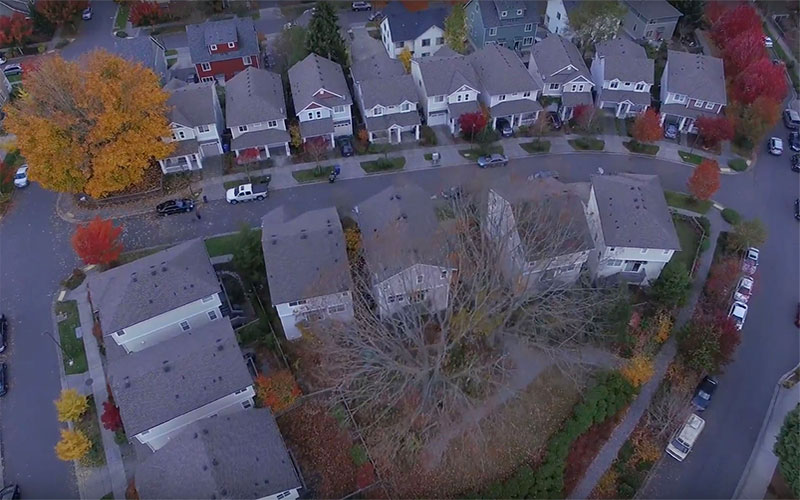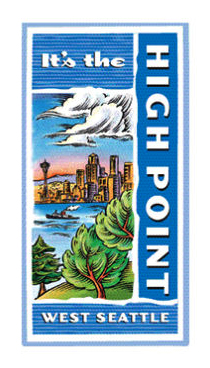THE STORY BEHIND HIGH POINT
High Point is one of the most significant developments in Seattle’s history—an award-winning mixed-income community and Seattle Housing Authority’s largest master-planned family community.
One of Seattle’s most diverse neighborhoods, High Point is recognized as the first dense urban development in the nation to achieve sustainable, low-impact design on a large scale. Among its numerous environmental achievements, High Point is the first Energy Star®-certified multifamily community in the nation, and features one of the largest stormwater drainage systems in the country.

Originally built in 1942 for defense workers, it was redeveloped into a new mixed-income community starting in the year 2000. The redevelopment, funded with a combination of public and private money under the federal HOPE VI program, replaced all of the development’s 716 worn-out public housing units, and added new housing for families and seniors designated to be affordable across a broad income range.
Today, High Point is a thriving community for over 4,000 people more than 1,500 homes (half market-rate homes, half affordable rental homes). It’s situated on 34 city blocks encompassing 120 acres, including 21 acres of green spaces of all types—from a three and one half-acre central park at the heart of the community to small pocket parks and trails. The community amenities, services, and open spaces are a magnet for both locals and visitors from the surrounding neighborhood.
With views of Puget Sound and Mount Rainier, a range of housing choices, convenient community services, and excellent access to downtown and transit, High Point is one of Seattle’s most desirable neighborhoods that also provides affordable housing to hundreds of residents.
Read more about the transformation of High Point, then and now.
Tom Phillips - Project Manager, Seattle Housing Authority
The green aspects became an important engine as we went along because they became an important rallying point for people who wanted to help. There was lots of support in the community for making High Point happen.
A TRIUMPH OF CIVIC COOPERATION
High Point has been cited as "a new model of cooperation" between residents, private developers, and government agencies. Its development brought together the social vision of the Federal Hope VI housing program and the livability principles of New Urbanist design—fostering a unique, earnest and visionary public-civic-community partnership.

The unusually inclusive process joined stakeholders with planners, architects, engineers, and city officials, including the Seattle Housing Authority, the departments of Planning, Development, and Transportation; and Seattle Public Utilities. Hundreds of civic and city leaders and businesses, as well as High Point's residents, met extensively to ensure that the High Point vision of diverse community and environmental stewardship was fulfilled on all levels.
This collaborative approach, with intensive outreach and in-depth public process, informed every element of design, and contributed the quality and imagination that make High Point what it is today.
Read more about the neighborhood design that cultivates community identity and connection.
Read more about the process that transformed High Point from run-down to renewed.
GREEN LIVING
High Point is renowned for its environmentally responsible design and healthy living initiatives. Designed and built to be the most progressive, environmentally friendly community in the country, it features one of the country's largest natural drainage systems, which protects wildlife by filtering rainwater before releasing it to Longfellow Creek.
Addressing neighborhood green space, pedestrian safety, and water quality simultaneously, the entire street grid was raised and replaced by a stormwater management system that includes bioswales, a stormwater pond, porous streets and sidewalks, and multifunctional open spaces among its innovative features.

Numerous other environmentally responsive strategies protect the watershed and community, while adding to the aesthetic appeal and diversity of the neighborhood and its green spaces. From water-conserving fixtures, to tree preservation and planting, to drought-resistant low-allergy native plants maintained using organic landscaping methods, High Point sets the standard for ecological sensitivity.
Seattle Housing Authority mandated that parks and open spaces at High Point be maintained using environmentally sensitive approaches. This is part of the plan to improve water quality for residents, as well as protect salmon runs and other wildlife by ensuring that stormwater flowing into Longfellow Creek is free of toxic substances.
At High Point's inception, organic landscaping methods were introduced on more than 20 acres of open space, including front and back yards, gardens, and pocket and neighborhood parks. These methods include use of organic pesticides and herbicides, as well as selection of native and drought tolerant plants.
The community's commitment to sustainable design (as well as community development for residents of all incomes) has garnered numerous awards.
Perhaps High Point’s most esteemed honor is the Urban Land Institute (ULI) Global Award for Excellence, recognizing High Point as an international model of sustainable mixed-income living. ULI is the pre-eminent organization on responsible urban development.
Thanks to these achievements, High Point has become a "must-see" destination for building and design professionals from all over the world. Experts, politicians, and filmmakers from all over the country have visited the site to study how High Point has implemented environmental values and standards to create a beautiful, diverse and affordable community.
Read more about the natural drainage system, heritage trees, and sustainable homes.
